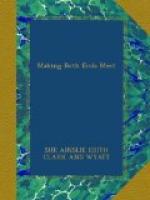There is undoubtedly, on both sides, need of patience and a long educational process to change the attitude of hostility and bitterness engendered by over twenty years of a false policy of antagonism. But never before, in the cloak makers’ history, have the men and women gone back to work after a strike holding their heads as high as they do to-day.[32] It can be reasonably believed that their last summer’s struggle will achieve a permanent gain for the workers’ industrial future. This narrative of the industrial fortunes of the women cloak makers in New York in the last year is given for its statement of the effects of the struggle for the Preferential Union Shop on their trade histories, and for its account of their gains as workers in the same trade with men.
These cloak makers’ gains were local. What national gains have American working women been able to obtain? For an answer to this question we turned to the results of the National Consumers’ League inquiry concerning the fortunes of women workers in laundries and its chronicle of the decision of the Federal Supreme Court on the point of their hours of labor.
FOOTNOTES:
[Footnote 23: Printed statement of the Cloak, Skirt, and Suit Manufacturers’ Protective Association, July 11, 1910.]
[Footnote 24: Estimate of the Waverly Place Office of the International Ladies’ Garment Workers’ Union, November 26 to 30.]
[Footnote 25: For this account of the position of different cloak manufacturers the writers wish to acknowledge the kindness of Miss Mary Brown Sumner of the Survey.]
[Footnote 26: These were the most important clauses of these early settlements as regards women workers:—
I. The said firm hereby engages the Union to perform all the tailoring, operating, pressing, finishing, cutting, and buttonhole-making work to be done by the firm in the cloak and suit business during one year ... from date; and the Union agrees to perform said work in a good and workmanlike manner.
II. During the continuance of this agreement, operators shall be paid in accordance with the annexed price list. The following is the scale of wages for week hands: ... skirt makers, not less than $24 per week; skirt basters, not less than $15 per week; skirt finishers, not less than $12 per week; buttonhole makers, not less than $1.10 per hundred buttonholes.
III. A working week shall consist of forty-eight hours in six working-days.
IV. No overtime work shall be permitted between the fifteenth day of November and the fifteenth day of January and during the months of June and July. During the rest of the year employees may be required to work overtime, provided all the employees of the firm, as well as all the employees of the outside contractors of the firm, are engaged to the full capacity of the factories. No overtime shall be permitted on Saturday nor on any day for more than two and a half hours, nor before 8 A.M. or after 8 P.M. For overtime work the employees shall receive double the usual pay. No contracting or subcontracting shall be permitted by the firm inside its factory, and no operator or finisher shall be permitted more than one helper.




